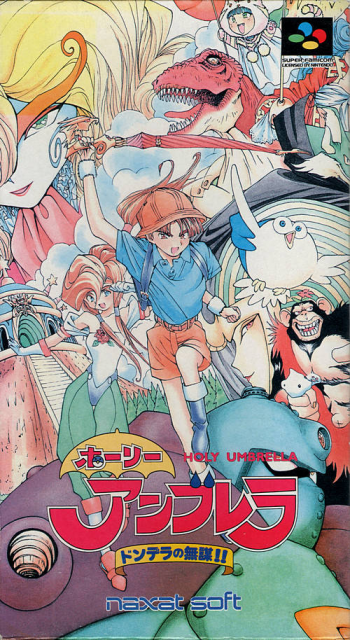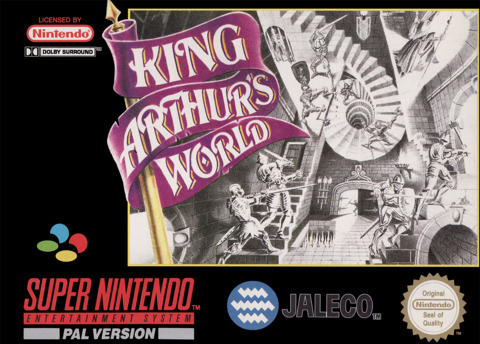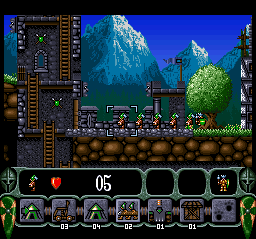The SNES Classic had a sterling assortment of games from Nintendo's 16-bit star console, but it's hardly all that system has to offer a modern audience. In each installment of this fortnightly feature, I judge two games for their suitability for a Classic successor based on four criteria, with the ultimate goal of assembling another collection of 25 SNES games that not only shine as brightly as those in the first SNES Classic, but have equally stood the test of time. The rules, list of games considered so far, and links to previous episodes can all be found at The SNES Classic Mk II Intro and Contents.
Episode IX: Holy Grails & Holy Umbrellas
The Candidate: Earthly Soft/Naxat Soft's Holy Umbrella: Dondera no Mubo

Focusing largely on action games and platformers for this feature regularly brings me into contact with Super Famicom games where, for the life of me, I don't understand why someone didn't think to localize it for a western audience. For one, the joke title of this game only really works in English: without knowing what the Japanese word for "holy" is, I can't imagine it's a homophone for "full of holes", which of course would make an umbrella useless (insert McBain "that's the joke" gif here). Holy Umbrella comes to us courtesy of Naxat Soft, they behind the similarly silly action game The Twisted Tales of Spike McFang which we covered a few episodes ago, as well as the developer Earthly Soft who had a small tenure in the late 90s producing games for major publishers. They only worked with Naxat on one more game after this: Touhou Chinyuuki: Hafling Hearts!!, a visual novel/RPG hybrid for the PlayStation that presents a distaff version of the frequently-sourced Chinese novel Journey to the West.
If I were to compare this game to one that might be a little better known, it would be the wonderfully "Japan weird" Kendo Rage, a.k.a. Makeruna! Makendou. Both games feature large sprites for their characters, which means more animation frames and details but a larger hitbox to deal with, and both feature a level of distinctive Japanese eccentricity that makes them hard to forget. Every boss in the game is named some variation of "Dondera", after their leader Emperor Dondera: so you face Dondera Tank, Dondera Kong, Dondera Sphinx, and so on. Emperor Dondera himself is a particularly odd creation: an effeminate antagonist who regularly breaks the fourth wall, gets mistreated by his underlings, flirts with the hero, and even joins the party for a small time as an overpowered playable character. The plot, as thin as it is, follows the "isekai" tradition of having the protagonist warped from our world into the magical world of the game via a magical umbrella in order to save it from its world-destroying villain. The broad strokes aren't really what matters, and the game's got enough of a sense of humor to lampshade the clichés (though, like many parodies, can't help adhering to those same tropes also) and create frequent moments of levity. Moments like a station master that insists you defeat him at rock-paper-scissors before he gives you a passport, or a lonely inventor who created a village full of unfailingly polite robots, or how the recurring useless Tank boss shows up to serenade you with an Enka ballad before fighting you for the third time. In retrospect, a lot of the jokes might be too entrenched in Japanese culture to be worth considering for global distribution: a concern that probably limited the number of Ganbare Goemon SNES games we recieved (we only had the one, but there were actually five Super Famicom Goemon games, including an Ebisumaru maze puzzle spin-off).
Holy Umbrella's structure might be the next most notable aspect about it after its comedic aspirations. The game is split up into action stages and settlements, the action stages all feature standard 2D platforming with a boss fight at the end, while the settlements have a slanted top-down view more typical of an RPG or a Zelda game. While in settlements, you can rest at inns to recover health, save the game, or buy consumables: the last of which require bottles to hold. You find new bottles by scouring both the settlements and action stages for chests, and you can also acquire power-ups that add to your strength, your defense, and your maximum HP. The game also provides new abilities on a regular basis, but there's no backtracking element: you should theoretically be able to find every chest the first time you pass through a stage. Abilities include being able to climb walls, run for longer jumps, and glide slowly down from jumps. You also pick up allies you can switch to, each with their own unique abilities. Finally, there's also the player's umbrella: you find new ones as the game progresses, each with their own elemental powers. To use them, you defeat enemies which produces an elemental orb, and then pick up and toss the orbs to activate them: the element defines their behavior, from firing straight ahead, to homing in on enemies, to spinning around the screen hitting as many foes as possible. Though the levels are short and relatively easy if you keep your consumables on-hand, there's a wide amount of versatility to how you can traverse them. If anything, the game doesn't utilize these abilities often enough, regularly tossing some new power your way after thirty minutes. It's a great game if you suffer from ADD, but it feels a little undercooked. If the pace of the action stages is too fast, it grinds to a stop when you enter settlements: in order to not miss any of the vital stat power-ups, you have to check every object in every house just in case. The game can be completed without every power-up (it's easy enough, as I said), but it doesn't hurt to find as many of them as possible, especially the bottles.
So, all in all, a memorable and charming platformer that perhaps skews too easy and too basic in pure mechanical terms. But how will it rate when processed through a whole stack of P.O.G.S.?
- Preservation: A lot of the timelessness I've seen in these SNES games is due to two factors; great pixel sprite work - which this game has, especially for its expressive animated character portraits - and a certain "before its time" ingenuity to the mechanics. While Holy Umbrella's amalgamation of action platforming and RPG elements might be novel for its time, it's an idea that's been iterated upon several times since then, and usually done better: Symphony of the Night and its kin, for example, or something like the Klonoa series. However, I will give the game props for its sense of humor: there aren't many SNES games that go for the funny bone quite as often as this one. 3.
- Originality: Holy Umbrella definitely scores points here for its humor and vast array of abilities, followers, and weapons. It never stops throwing new concepts at you, configuring each dungeon to suit whatever new piece of equipment you've acquired or new skill you've learned. One dungeon has you swimming up waterfalls, while another has you using a special device to find holes in the walls to pass through. There's also no predicting where the story will go either, as you regularly have to pause your quest to save a village from petrification, or recover an artifact from Dondera's minions, or even deal with, say, an evil mermaid pirate commanding a whale to eat the ocean-crossing bullet train you were riding. 4.
- Gameplay: The gameplay is perhaps the weakest and most underdeveloped aspect of the game. While you do have all these abilities, levels are very easy and short. Boss fights, though they involve memorable foes, are simple battles of attrition when you have healing items to spare and no penalty for death - you simply start the fight over if that happens. It's evidently aimed towards a younger audience, even if the jokes can be a bit racy at times. There was potential to include backtracking to earlier levels with certain power-ups, or having to use a combination of the abilities you've acquired so far to solve more difficult platforming sequences, but there's very little of either to be seen here. I particularly liked using the playable character of Saki, who is sort of the love interest to the hero, because of the way she could wall-jump and slide like the hero of Ninja Gaiden - but there's few places to use her beyond the one vertical dungeon you need her for. 3.
- Style: Like a number of Super Famicom games, Holy Umbrella's art direction benefits from having a ringer brought in. In this particular case, that ringer is manga artist and author Tatsuya Egawa, best known for Magical Taluluto (which also saw a Super Famicom game) and the comparatively adult Golden Boy. His art style is best expressed in those aforementioned animated portraits whenever characters talk, and there's around thirty unique NPC portrait sprites all told. The large character sprites, though they do lead to a lot of annoying hitbox issues, at least look good too. I enjoyed the game's music also: a mix of fairly traditional fantasy RPG music with slightly more brassy comedy tracks in the style of a Parodius, but there were also a few tracks that stuck with me, including this slightly eerie dungeon BGM and the "Dondera!"-spouting boss tune. 4.
Total: 14.
Other Images:
The Nominee: Argonaut Games's King Arthur's World

If it feels like I'm dividing my time between Japan and the UK for this feature, that's largely by design. Japan had all the best games, though it often feels like precious few ever passed through the language barrier, and the UK is my stomping ground, so I'll always hold some affinity towards games developed here. Previously in this series we've featured Software Creations's Equinox and Rare's Battletoads in Battlemaniacs, and this week we check in with Argonaut Games and King Arthur's World. If the developer's name sounds vaguely familiar, these are the guys who innovated in 3D polygonal tech on hardware that wouldn't normally support it back on the Atari ST and Amiga with their wireframe shooter Starglider, which eventually lead to them working with Nintendo get the technologically impressive (though pretty aged now) Star Fox franchise off the ground. While King Arthur's World doesn't boast any showy 3D blocks made of triangles, it was one of the earliest games to exhibit a certain other technological feat: full Dolby surround sound. I think the idea was that it would help you narrow down where the death cries of your men were coming from. It's also one of the few SNES games to support the SNES Mouse, though it's totally playable without it.

King Arthur's World is a puzzle-RTS game that's part Lemmings, in particular the way you can assign units with specific jobs to do and the overall look of the 2D playing area, and something a bit more warfare focused like Warhammer or Warcraft. Each scenario of the game requires that you bring the sole "hero unit", the titular mythical King of the Britons, to a treasure found deep in the level. To get to it, you need a combination of units to remove all the obstacles in the way - both enemies and traps - so the King can safely trot over to where he needs to be. These obstacles can include enemy knights, enemy archers, enemy wizards, explosive traps, spike traps, boiling oil traps, pits, tall walls, goblins, dragons, teleporting demons, and more. On your side you have a level-determined number of your own knights and archers, engineers that can craft multiple constructions from bridges to catapults, your own wizards in black and white flavors (the former for fireballs and the latter for healing, naturally), and little guys with explosive barrels for when you need a gate or an incoming enemy legion blown away. Each set of levels culminates with a boss fight against a colossal foe, usually requiring the full force of your army to fell it before it can reach the King, and then the next set of scenarios get even more outlandish and difficult. It's an inventive game and a criminally overlooked one, though I'm hoping to help in some small way fix the latter.
King Arthur and his army of loyal soldiers have toppled many an enemy tower, but how will they fare against a tower of P.O.G.S.?
- Preservation: King Arthur's World endures because there's literally no other game like it on the system, nor have there been too many games like it since. It has one foot in the world of 2D puzzle-platformers like Lemmings, Humans and Gussun Oyoyo (I just had to slip in one weird Japanese game, huh) and another in the tactical war RTS games that usually adopt a more top-down or isometric viewpoint. It might be a bit sluggish for today's audience, and it lacks a whole of complexity with its small number of troop types, but it has yet to be despoiled by generations of imitators improving on the formula: a fate that has aged a lot of other 16-bit games. 4.
- Originality: Its originality is key to its appeal, as stated above, but beyond the core mechanics and the (admittedly generic) King Arthur fantasy motif, there's a lot of smart ideas packed into this game. Like the way the fire physics spread to adjacent combustible items in almost like a grid structure, or how the game helps you track multiple units when they're off-screen, or the Artillery-like way the catapults operate and the repercussions that can ensue from its aftereffects. Argonauts were never one to rest on their laurels, even for more graphically straightforward games like this. 4.
- Gameplay: King Arthur's World has the flaw of taking a few good ideas and repeating them far too often, especially after the first "world" is complete. Many of the later stages basically boil down to summoning the same apposite units for whatever obstacle is in the way, and then gradually working your way through the all the level's challenges until you have the "Gait of Victory" as Arthur - who is usually left near the start for safekeeping - languidly paces to the end. While it may outstay its welcome a bit, those early stages and their fun designs, as well as the novelty of the game and its mechanics, makes for a strong first impression. 4.
- Style: While I like the game's intricate sprite work and backgrounds, it's a plain looking game, even when you get to the cloud kingdom and the madness that awaits you up there. The music's perfunctory and because the various characters are so small there's not a whole of character to be exhibited. The presentation often feels like a framework for the mechanics as a result, which isn't so much of a bad thing. 3.
Total: 15.
Other Images:












Log in to comment